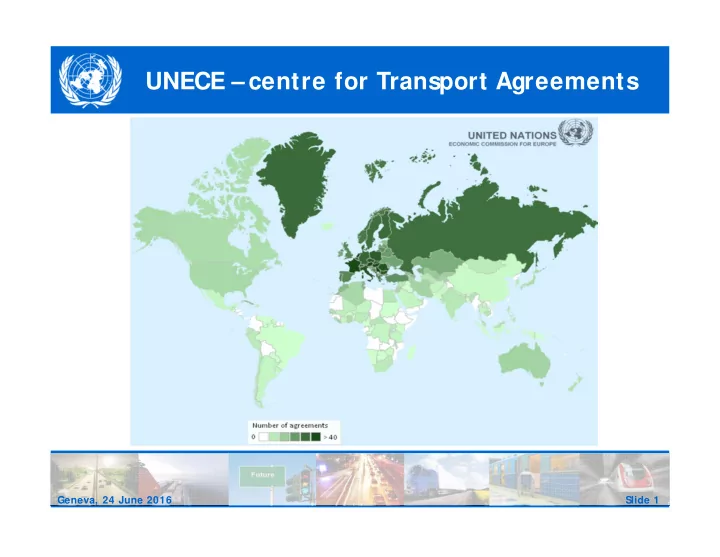

UNECE – centre for Transport Agreements Geneva, 24 June 2016 Slide 1
The core areas of UNECE work Geneva, 24 June 2016 Slide 2
UNECE’s 360 0 approach to Border crossing facilitation : Geneva, 24 June 2016 Slide 3
Border crossing facilitation : On some maj or routes, 57 % of transport time is lost at border crossings. • Long waiting times at borders result in maj or human suffering for drivers blocked in queues for hours/ days • harmful impact on the environment • Border waiting times also cost billions annually => increasing the cost of goods for the end consumer, not to mention lost business opportunities. Border crossing facilitation is: • Key to international trade, exports and imports • Essential for growth and competiveness • A driver of regional integration Geneva, 24 June 2016 Slide 4
UNECE’s 360 0 approach to Border crossing facilitation (2) Crossing borders requires: • Appropriate and resilient infrastructure • Reliable and harmonized international legal framework • Harmonized or at least aligned procedures (e.g. customs) • International cooperation and exchange of best practices Geneva, 24 June 2016 Slide 5
The Harmonization Convention, 1982 - International Convention on the Harmonization of Frontier Controls of Goods - 56 Contracting Parties - Latest accessions: Iran, Taj ikistan - Expressed interest to j oin: China Geneva, 24 June 2016 Slide 6
Objective and Scope To facilitate cross border transport of goods through nationally coordinated, internationally harmonized, shorter, reduced formalities and controls of goods at borders It covers: • All goods moved across borders (exported, imported or in transit) • All control services • All modes of transport • S pecific provisions for certain transport modes and goods • Also addresses certain issues with regard to vehicles and drivers Geneva, 24 June 2016 Slide 7
Main characteristics The Convention provides a framework that enables: • Harmonization of formalities • Reduction of the number and duration of controls • S tandardization of documentation • Co-ordination of national and international control procedures Leading to : • Reduction of border delays • Reduction of transport cost • Reduction of trade transaction cost • Reduction of border operating costs for S tate budget • More efficient investments in border facilities Geneva, 24 June 2016 Slide 8
The TIR Convention, 1975 • Global United Nations Convention; • Establishes and regulates the only existing and operational global customs transit system; • Administered by the established Treaty bodies in Geneva under UNECE auspices. Slide 9 Geneva, 24 June 2016
Objectives • Border crossing facilitation through an internationally recognized and harmonized procedure; • Effective revenue protection and security without excessive administrative burden for customs and time/ cost losses for operators Geneva, 24 June 2016 Slide 10
How it works • S ecure vehicles or containers; • S ingle, internationally valid guarantee coverage; • S ingle internationally accepted document, the TIR Carnet; • Mutual Recognition of Customs controls; • Controlled access to the procedure; Geneva, 24 June 2016 Slide 11
Adapting to modern needs 1. Electronic risk management tools 2. Discussions on additional facilities such as authorized consignor/ consignee 3. Computerization process (eTIR) is underway: Finalization of the eTIR Reference Model (conceptual) Adaptation of the legal framework (legal) Development of the required systems (technical) Corridor based step-by-step implementation Geneva, 24 June 2016 Slide 12
Adapting to modern needs Geneva, 24 June 2016 Slide 13
Customs Convention on Containers, 1972 • Obj ective • To facilitate the temporary admission in a country of containers registered in another country by deferring payment of taxes and duties • Benefits • Minimum border procedures, deferred payment of Customs taxes and duties • Recovery of Customs duties if no re-export • Facilitated international goods transport Geneva, 24 June 2016 Slide 14
Customs Convention on the Temporary Importation Private Road Vehicles, 1954 • Establishes the principle of temporary importation of vehicles under the cover of the international "Carnet de Passage en Douane“ • CPD guarantee payment of import duties and taxes of the vehicles to national competent authorities if the vehicle, that has been temporarily admitted, is not re-exported. Geneva, 24 June 2016 Slide 15
Access to UNECE legal instruments Open to all UN Member S tates Many non-ECE S tates are already Parties The UN S ecretary-General is the Depositary To become a Party, deposit an instrument with the S -G No accession fee Geneva, 24 June 2016 Slide 16
UNECE/ TIR S ECRETARIAT 8-14, Avenue de Paix CH-1211 Geneva 10 S witzerland Phone: +41 22 917 41 36 Email address: Miodrag.Pesut@ unece.org Geneva, 24 June 2016 Slide 17
Recommend
More recommend